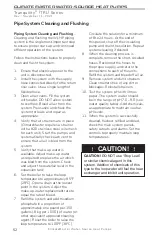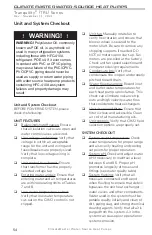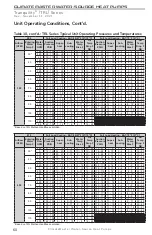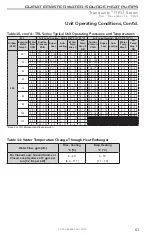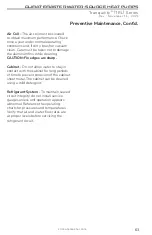
CLIMATEMASTER WATER-SOURCE HEAT PUMPS
Tranquility
®
(TRL) Series
R e v. : N o v e m b e r 1 1 , 2 0 2 1
C l i m a t e M a s t e r Wa t e r-S o u rc e H e a t P u m p s
52
Pipe System Cleaning and Flushing
Piping System Cleaning and Flushing
-
Cleaning and flushing the WLHP piping
system is the single most important step
to ensure proper start-up and continued
efficient operation of the system.
Follow the instructions below to properly
clean and flush the system:
1. Ensure that electrical power to the
unit is disconnected.
2. Install the system with the supply
hose connected directly to the return
riser valve. Use a single length of
flexible hose.
3. Open all air vents. Fill the system
with water. DO NOT allow system
to overflow. Bleed all air from the
system. Pressurize and check the
system for leaks and repair as
appropriate.
4. Verify that all strainers are in place
(ClimateMaster requires a strainer
with a #20 stainless steel wire mesh
for each unit). Start the pumps, and
systematically check each vent to
ensure that all air is bled from the
system.
5. Verify that make-up water is
available. Adjust make-up water
as required to replace the air which
was bled from the system. Check
and adjust the water/air level in the
expansion tank.
6. Set the boiler to raise the loop
temperature to approximately 85°F
[29°C]. Open a drain at the lowest
point in the system. Adjust the
make-up water replacement rate to
equal the rate of bleed.
7.
Refill the system and add trisodium
phosphate in a proportion of
approximately one pound per 150
gallons (.8 kg per 1000 l) of water (or
other equivalent approved cleaning
agent). Reset the boiler to raise the
loop temperature to 100°F [38°C].
Circulate the solution for a minimum
of 8 to 24 hours. At the end of
this period, shut off the circulating
pump and drain the solution. Repeat
system cleaning if desired.
8. When the cleaning process is
complete, remove the short-circuited
hoses. Reconnect the hoses to
the proper supply, and return the
connections to each of the units.
Refill the system and bleed off all air.
9. Remove system and unit strainers.
Clean strainers free of any dirt or
blockages. Reinstall strainers.
10. Test the system pH with litmus
paper. The system water should
be in the range of pH 7.0 - 9.0 (see
water quality table). Add chemicals,
as appropriate to maintain neutral
pH levels.
11. When the system is successfully
cleaned, flushed, refilled and bled,
check the main system panels,
safety cutouts and alarms. Set the
controls to properly maintain loop
temperatures.
⚠
CAUTION!
⚠
CAUTION!
DO NOT use “Stop Leak”
or similar chemical agent in this
system. Addition of chemicals of this
type to the loop water will foul the heat
exchanger and inhibit unit operation.















